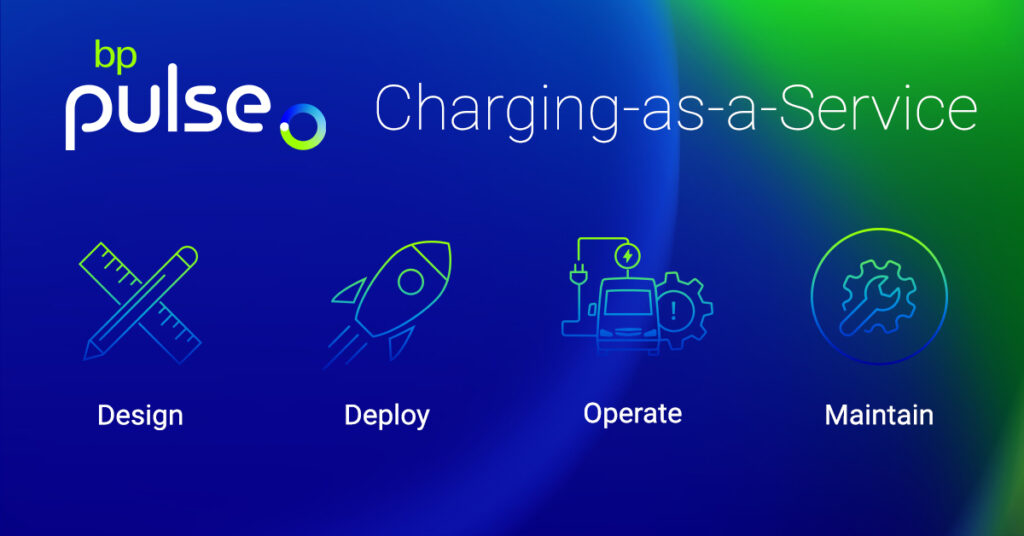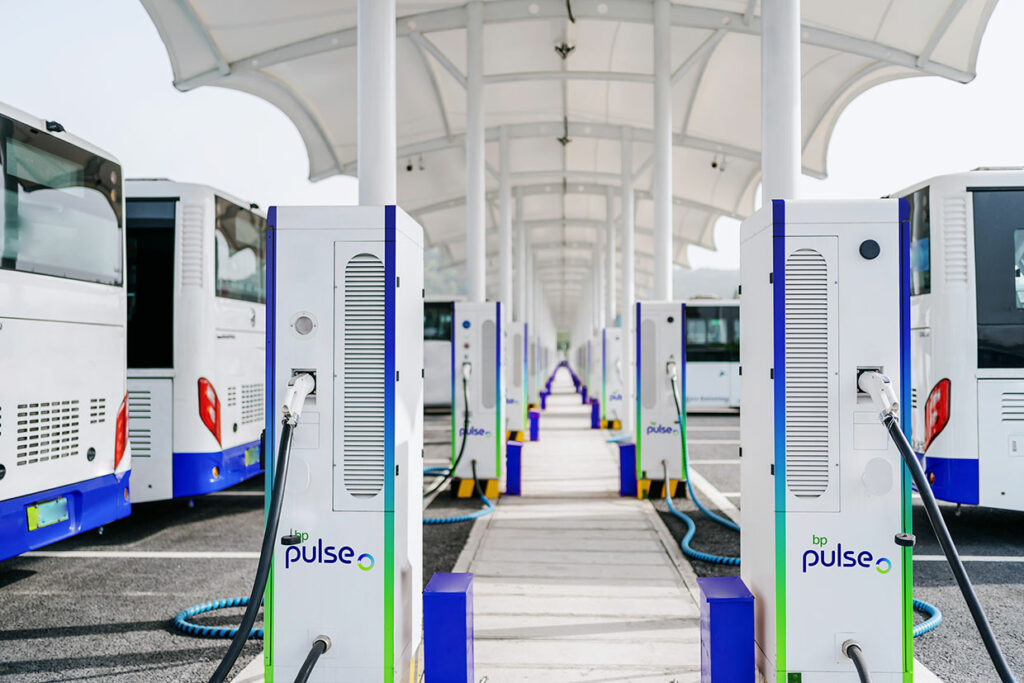Charging-as-a-Service
What is Charging-as-a-Service and how can it help you electrify?

As you get started with the transition to an electric fleet, you’ll likely discover the process requires you to become an expert on electric vehicles right away, including understanding charger types, technology compatibility, site construction, utility engagement, and electrical systems. That’s quite a lot to figure out in and of itself, not to mention the time commitment and initial capital investment required to get up and running.
Charging-as-a-Service (CaaS) is an alternative to that process, combining site design, infrastructure deployment, intelligent software, and comprehensive service to provide a hassle-free solution with reduced upfront costs.
bp pulse Charging-as-a-Service benefits
Through bp pulse’s CaaS, we provide a holistic solution that assumes responsibility for all aspects of charging an EV fleet. We handle all of the project management–bundling CapEx, OpEx, energy costs, and incentives into fixed rate, $/kWh or $/mile driven. This adds a layer of predictability to your operations and streamlines your onboarding process. Most critically, our CaaS solution includes a 99.9% uptime guarantee, so you can rest assured that your fleet assets are ready when you need them.
For example, by working with us, Palermo Union Elementary School District contracted an energy rate of $0.10/kWh, or $1.19 per gallon, through bp pulse’s fully-managed, turnkey charging services. Without these contracted rates, the price could be up to 2x higher than managed charging rates.
We work closely with fleet customers to deploy CaaS through four main phases: design, deploy, operate, and maintain, which I’ll go over in more detail in this blog.
The four phases of Charging-as-a-Service
Phase 1: Design
At the beginning of the electrification journey, fleets are often faced with choosing the right equipment and installation process alone. With so many options to choose from, this first barrier can be a lengthy and expensive process. CaaS begins working with the fleet from the very beginning to avoid costly delays to your EV fleet deployments.
Most critically, our CaaS solution includes a 99.9% uptime guarantee, so you can rest assured that your fleet assets are ready when you need them.
When we first start working with a CaaS customer, we begin by assessing the specs of your EVs, depot location, fleet duty cycles, and load profile to design an initial site plan. This plan outlines charger location, the required electrical gear, and important aspects of the construction process. In addition to this, we provide charging strategy analysis and EVSE recommendations, helping you select the right equipment for your fleet from the start.
To help mitigate lengthy equipment lead times, we plan to order chargers for our customers in this first phase to ensure timely delivery of your charging infrastructure. Next, engineering drawings are completed and the permitting process begins to prepare for deployment.
Phase 2: Deploy
Once your equipment is identified and the site layout defined, the construction process can begin. One of the challenges fleets often face in this phase is identifying the correct entities to work through construction and permitting, and juggling the variety of stakeholders and timelines necessary to complete the project. Throughout this phase, bp pulse’s CaaS provides comprehensive project management — we select licensed subcontractors, secure permits, commission equipment, and coordinate with your utility to ensure project implementation happens on time.
The next step in the deployment stage is testing and commissioning your infrastructure and all equipment. bp pulse Field Service Technicians work to confirm your site is operating properly and as designed so you can kick off the fun part — operating your new electric vehicle fleet!
By allowing us to manage all aspects of charging infrastructure installation, fleets can look forward to cost savings, while we simplify the entire process and guarantee performance.
Phase 3: Operate
Once your chargers are installed and energized by your utility, you are ready to plug in your new EVs. At this stage, including charge management software (CMS) in your fleet operations helps keep energy costs low and increases vehicle uptime.
bp pulse’s CMS offering, Omega, takes the guesswork out of charging your EV Fleet, with no active management needed on your part. With Omega, you can:
- Automatically charge at the lowest energy cost time frames;
- Track vehicle state-of-charge, route status, and more;
- Receive real-time alerts to manage charger faults or interruptions in your service, and proactively start error resolution;
- Integrate with your utility to automatically monitor site and charger load profiles, ensuring you never go over your site load capacity; and
- Easily run savings, energy, GHG emission reductions, and other operational reports.
This all takes place in a user-friendly dashboard. Learn more about the benefits of Omega charge management software.
Once your fleet is up and running, keeping up on maintenance is critical to ensuring vehicle uptime and maximizing your total cost of ownership, which is why we include it in our CaaS model.
Phase 4: Maintain
While EVs are typically less complicated and require less maintenance over the lifetime of the vehicle compared to internal combustion engine vehicles, the technology is often very new to fleet operators and mechanics. Additionally, no longer are you maintaining just the vehicles, but the charging infrastructure as well.
To help keep your vehicles and charging equipment running without much effort on your part, bp pulse’s CaaS includes hassle-free, preventative maintenance and support that goes beyond existing equipment warranties provided by manufacturers.
Should an issue arise in your operations, bp pulse CaaS runs a holistic diagnostic and problem mitigation process, which includes triage, troubleshooting, problem isolation, and remote or onsite repair or replacement of your affected equipment. bp pulse also handles firmware updates and end-of-life processing on your behalf.
By allowing us to manage all aspects of charging infrastructure installation, fleets can look forward to cost savings while we simplify the entire process and guarantee performance.
Cost savings with Charging-as-a-Service
In addition to the savings already mentioned above, CaaS can further increase your bottom line by bundling funding from grants and incentive programs. This includes money a fleet may be eligible to receive through state and local clean air programs, local utilities, and low carbon fuel credit programs (LCFS).
Implementing an LCFS program on your own can require a lot of administration time, instead, we can collect and monetize LCFS credits on your behalf, reducing your total cost of ownership. Our team of experts can also help you take advantage of renewable energy credits, ensuring your EV fleet is fueling with 100% renewable electricity, or participate in demand response, vehicle-to-grid, and other programs. An example of this is our work with Tri Delta Transit to help them leverage LCFS credits that was just money being left on the table.
We’ve helped many fleet customers install charging infrastructure without the hassle and expensive upfront costs of going it alone. bp pulse can be your partner in electrification! Learn more about bp pulse’s Charging-as-a-Service solution here.
Go further

Find out what Charging-as-a-Service can do for your fleet
bp pulse’s Charging-as-a-Service removes the burden of high capital investment and stakeholder engagement with comprehensive project management and amortized costs.
Date
27 July 2022
author

Meg Dinga
Senior Director, Marketing Operations and Special Projects
bp pulse fleet
Topics


